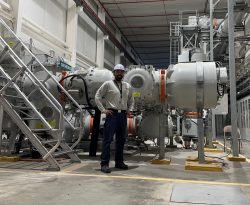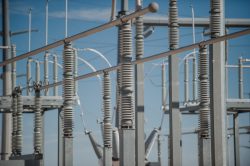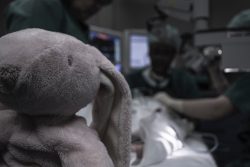
A web of power lines, substations and technology stands strong like a silent guardian, powering lives, industries, and futures. Across northern Illinois, it’s the lifeline to nearly every corner of our lives.
Those who dedicate their careers to the maintenance of the ComEd electric grid, and the institutions it supports, give us a glimpse of the grid’s resilience and the stories of the people it touches.

Cesar Castillo, ComEd’s senior engineer in the Transmissions & Substation Equipment Standards & Fire Protection group
Cesar Castillo, ComEd’s senior engineer in the Transmissions & Substation Equipment Standards & Fire Protection group, understands the urgency of protecting and enhancing the grid. With changing customer demands and the challenges of climate change, engineers like Cesar take a proactive approach to maintaining the grid.
“We need to be able to provide reliable substations, advanced technology, and an unyielding pursuit of resilience,” says Cesar. “It’s all to ensure that the grid thrives in the face of extreme changes, unfazed by the harshest winters or the hottest summers, and all of that goes along with the grid enhancements,”
ComEd’s operational teams pay close attention to the ever-changing weather conditions. Their vigilance is a testament to their commitment. If extreme weather is expected, such as the recent heat wave across Chicago, substation personnel are dispatched to put their eyes on the equipment, monitoring gauges (measuring instruments such as pressure gauge and oil level gauge), as well as measuring with thermal guns to analyze and identify potential hot spots or issues.
“We start evaluating what the grid needs to stay safe,” says Cesar. “Are there any transformers, circuit breakers or other equipment that have open issues that might have a problem in the extreme weather? Is all the equipment working properly and in normal configurations?” It takes a committed team to ensure that each component is ready to face the elements, and ready to keep society illuminated even in harsh conditions.
The Digital Era

Ensuring reliability goes beyond physical maintenance; it also involves embracing new ideas, driven by technology. The smart grid is more than just a buzzword; it’s the example of a brighter future. By using advanced technology, ComEd ensures better service for customers.
Cesar explains, “Taking care of the grid physically is one improvement. There’s also an analytical side, which moves everything to a completely digital system. For example, if one substation is having problems, it communicates digitally to another station for support.”
This interconnected system is a demonstration of innovation within ComEd, where data flows like water, ensuring the operation of an ever-changing grid.
Cesar adds that they must prioritize substations in areas of critical need, such as hospitals and airports. These locations are notably marked within ComEd’s system, to point out the significance of addressing possible concerns with highest urgency. The high priority of these sites ensures intensive efforts to prevent any potential disturbances, facilitated by regular inspections that reinforces resilience and prompt adjustments of any identified problems.
Even in the face of equipment failures, backup plans are layered to safeguard these essential locations, “we’re always keeping an eye on the equipment, from properly maintaining it to upgrading to the newest technology. ” Thanks to these measures, customers across northern Illinois are now experiencing record reliability, a testament to the effectiveness of resilience and backup strategies.
A Hospital’s Heartbeat
 While ComEd protects the grid, La Rabida Children’s Hospital protects the lives of children. For over a century, this hospital has treated children who have complex medical conditions and need special care. Every year, La Rabida staff care for over 9,000 children, providing empathy and top-quality treatment.
While ComEd protects the grid, La Rabida Children’s Hospital protects the lives of children. For over a century, this hospital has treated children who have complex medical conditions and need special care. Every year, La Rabida staff care for over 9,000 children, providing empathy and top-quality treatment.
Theresa Martinez, Vice President of Patient Care Services & Chief Nursing Officer says, “Having reliable power is critical for La Rabida because the children we care for often need medical technology that requires electricity to operate, such as, ventilators, IV drugs and nutrition, oxygen, cardiorespiratory monitors, dialysis and more.”
Unlike regular businesses, hospitals never close, which means that they need constant electricity for vital operations — even when the area is experiencing extreme weather conditions.
“Our hospital is never closed, like any hospital, so we rely on electricity to keep all things operating smoothly 24 hours a day, 7 days a week, 365 days a year,” says Theresa. “This goes beyond lights. It means we need electricity for storing medication, operating computers, monitoring patients, preparing meals, communication, and so much more.” ComEd’s dedication allows places like La Rabida to do the important work of saving lives — the grid’s reliability directly relates to quality of care.
So, next time you flick a switch, and the room lights up, remember the story behind that simple act. It’s a story of tireless engineers, vigilant crews, and unwavering institutions. It’s a story of a grid that stands strong, no matter the challenge.
